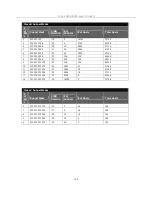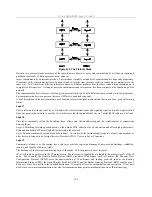
D-Link DES-3326S Layer 3 Switch
The UDP header is shorter than a TCP header. UDP also uses a checksum to verify that data is received uncorrupted.
The Internet Control Message Protocol (ICMP) is also a simplified protocol used for error messages and messages used by
TCP/IP. ICMP, like UDP, processes messages that will fit into a single packet. ICMP does not, however use ports because
its messages are processed by the network software.
The Domain Name System
Computer users usually prefer to use text names for computers they may want to open a connection with. Computers
themselves, require 32 bit IP addresses. Somewhere, a database of network devices’ text names and their corresponding IP
addresses must be maintained.
The Domain Name System (DNS) is used to map names to IP addresses throughout the Internet and has been adapted for use
within intranets.
For two DNS servers to communicate across different subnets, the
DNS Relay
of the DES-3326S must be used. The DNS
servers are identified by IP addresses.
Mapping Domain Names to Addresses
Name-to-address translation is performed by a program called a Name server. The client program is called a Name resolver.
A Name resolver may need to contact several Name servers to translate a name to an address.
The Domain Name System (DNS) servers are organized in a somewhat hierarchical fashion. A single server often holds
names for a single network, which is connected to a root DNS server – usually maintained by an ISP.
Domain Name Resolution
The domain name system can be used by contacting the name servers one at a time, or by asking the domain name system to
do the complete name translation. The client makes a query containing the name, the type of answer required, and a code
specifying whether the domain name system should do the entire name translation, or simply return the address of the next
DNS server if the server receiving the query cannot resolve the name.
When a DNS server receives a query, it checks to see if the name is in its subdomain. If it is, the server translates the name
and appends the answer to the query, and sends it back to the client. If the DNS server cannot translate the name, it
determines what type of name resolution the client requested. A complete translation is called recursive resolution and
requires the server to contact other DNS servers until the name is resolved. Iterative resolution specifies that if the DNS
server cannot supply an answer, it returns the address of the next DNS server the client should contact.
Each client must be able to contact at least one DNS server, and each DNS server must be able to contact at least one root
server.
The address of the machine that supplies domain name service is often supplied by a DCHP or BOOTP server, or can be
entered manually and configured into the operating system at startup.
199
Содержание DES-3326SRM
Страница 1: ...D Link DES 3326S 24 Port Layer 3 Stackable Switch Manual May 2005 651ES3326S055...
Страница 242: ......
















































